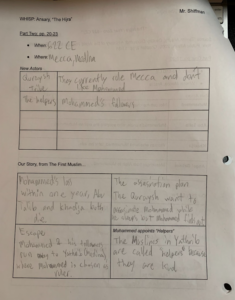Teachers of history and social studies on all grade levels know they want students to do more than just memorize facts; they want students to practice thinking about history as well. This is a valuable and important goal. Humans remember what we think about, so actually engaging intellectually with history will help students to remember more of it. And as citizens of a democracy, we want our students to be able to grapple with history, politics, and social and civic questions actively and critically. Active thinking in social studies class is good practice for active citizenship.
Curriculum writers should be conscious of this goal and should have a systematic way of achieving it: they need a definition of historical thinking that they can incorporate consistently into courses, units, and lessons. Unfortunately, the most widely available definitions of historical thinking are too convoluted and confusing to be practical for classroom use, so most teachers ignore them. The Four Question Method (4QM) is different. Its conception of historical thinking is accessible to students and teachers on all grade levels, and robust and rigorous enough to challenge the most sophisticated thinkers.
Two Advantages of 4QM Thinking Skills
The 4QM approach is different from better known definitions of historical thinking skills in two important ways. First, it is simple. The defining insight of the Four Question Method is that every important question in history/social studies is a specific version of one of only four questions: What happened? What were they thinking? Why then and there? What do we think about that? And each question is linked to the historical thinking skill used to answer it: narration, interpretation, explanation, and judgment. There are only four questions in our field, and only four thinking skills.
Contrast this approach with two widely available descriptions of historical thinking skills that we address in an appendix in our book: the College Board’s Advanced Placement (AP) historical thinking skills, and the Common Core Standards’ social studies thinking skills. The College Board defines six AP historical thinking skills and three additional “reasoning processes.” If we count up the subheadings under each one we total twenty-six intellectual tasks. The Common Core identifies Social Studies Skills for three grade ranges: 6-8, 9-10, and 11-12, each with nine thinking skills grouped into two or three categories. If we total them up, it’s twenty-seven intellectual tasks. All of this complexity presents curriculum writers with a daunting challenge. Which thinking skills are most important? How should all of them be incorporated into lesson plans and assessments, and how often? In our long experience as classroom teachers and administrators, we’ve seen that most history and social studies teachers respond to lengthy descriptions of historical thinking like these by simply ignoring them.
The 4QM’s second advantage is that it clearly defines the intellectual outcome of each question, thus giving teachers and students a goal to aim at, rather than just a long list of tools to be used. 4QM students (and teachers) know that the goal of history and social studies instruction is to coach students to produce strong narrations, interpretations, explanations, and judgments. All of these tasks require the kinds of thinking skills described by the College Board or Common Core, but 4QM students know why they are doing things like reading primary sources, comparing and contrasting two different places or two different times, or synthesizing information from a variety of sources. 4QM curriculum writers consistently incorporate these sorts of thinking activities into units and lessons organically — not just to tick off a box on a list of historical thinking skills. When everyone in the room understands the intellectual outcome goal, lessons are more clear and purposeful, and students are more motivated.
Some readers might object that 4QM oversimplifies historical thinking skills. We don’t think so. All four questions are easy to ask (that’s what makes them so accessible), but if taken seriously they are all difficult to answer. This is especially true for students who are learning a particular history for the first or second time, but it remains true even for adults who work in the field. Curriculum experts we’ve worked with have described the Four Questions as “simple yet profound,” and “accessible but really deep.” If you like reading academic history, you’ll notice that even the most abstruse and sophisticated texts (and disputes about them!) reflect the structure and logic of the four questions.
The “Swiss Army Knife” of History Teaching
One of our favorite compliments on the Four Question Method came from a fifth grade teacher in a Massachusetts public school. He said:
“The Four Question Method is the Swiss Army knife of history teaching: it gives me four tools, each with multiple uses. It cuts through all the red tape I have in my head about planning, and gives me and my students a clear and smart way to think about what we’re learning.”
Long and confusing lists of “thinking skills” fill curriculum planners’ heads with red tape. The Four Question Method cuts through all that with a clear definition of the intellectual tasks that we undertake in history and social studies. Planning courses, units, and lessons around these tasks gives students consistent practice in the kind of thinking that strong scholars and engaged citizens use in their everyday lives. And that should be a major goal of teaching history and social studies in the first place.
J.B.
